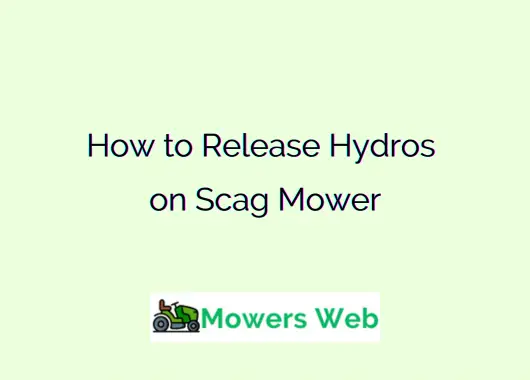To push a Scag mower without running the engine, you must release the hydros to disengage the hydrostatic transmission, putting the mower in neutral. This post guide provides a comprehensive, step-by-step guide to releasing the hydros on a Scag mower, with tips to ensure the process is safe and effective.
How to Release Hydros on Scag Mower
Safety First
Take these precautions:
- Park on a Level Surface: Ensure the mower is on flat ground to prevent it from rolling unexpectedly.
- Turn Off the Engine: Make sure the engine is off and the key is removed from the ignition.
- Engage the Parking Brake: This adds an extra layer of safety to keep the mower stationary while you work.
Step 1: Locate the Hydro Release Valves
The hydro release valves, also known as bypass valves, are typically located on the hydrostatic pumps or transaxles under the mower. For most Scag models, such as the Cheetah or Turf Tiger, these valves are found on the Hydro-Gear or Parker transaxles.
You may need to get underneath the mower to access them, so ensure you have enough clearance or use a jack to lift the mower safely.
Tip: On some models, like the Scag Cheetah, the valves are hexagonal nuts with a hole drilled through them, requiring a screwdriver or wrench to turn. Check your owner’s manual for the exact location and type of valve.Step 2: Gather the Necessary Tools
You’ll likely need a screwdriver (flathead or Phillips, depending on the valve) or a wrench (typically 5/8-inch). Some models may require additional tools, so keep a basic toolkit handy. Wear gloves to protect your hands and ensure good lighting to see the valves clearly.
Related How to Release Parking Brake On John Deere Tractor
Step 3: Disengage the Hydro Valves
Once you’ve located the release valves (one for each pump, corresponding to the left and right wheels), follow these steps:
- Insert the Tool: For valves with a slotted head, insert a screwdriver into the slot. For hex-shaped valves, use a wrench.
- Turn the Valve: Rotate the valve counterclockwise, typically a quarter to half turn, to open it. This releases the hydraulic pressure, allowing the wheels to move freely. Be gentle—over-tightening or forcing the valve can damage it.
- Repeat for Both Sides: Most Scag mowers have two pumps, so you’ll need to release both valves (one for each wheel) to fully disengage the transmission.
Step 4: Verify the Mower is in Neutral
After releasing both valves, gently push the mower to confirm it moves freely. If it doesn’t, double-check that both valves are fully open. Some resistance may occur if the parking brake is still engaged, so ensure it’s released before pushing.
Related Scag Check Engine Light Codes(Learn and Fix)
Step 5: Move the Mower
With the hydros released, you can now push the mower to your desired location, such as onto a trailer or into a garage. Move slowly and carefully, especially on slopes, as the mower will roll freely without the hydro system engaged.
Step 6: Re-engage the Hydro Valves
Once you’ve moved the mower, you must re-engage the hydro valves to restore normal operation:
- Return to the Valves: Locate the same release valves you opened earlier.
- Turn the Valve Clockwise: Rotate each valve clockwise until snug (but not overly tight) to close the bypass and re-engage the transmission.
- Check for Leaks: Inspect the valve area for any hydraulic fluid leaks, which could indicate a loose valve or damaged seal.
Related Best Chute Blocker for Scag Mowers(Best Top 5)
Step 7: Test the Mower
Start the engine and test the mower’s movement to ensure the hydro system is functioning correctly. If the mower doesn’t move as expected, recheck the valves to ensure they’re fully closed or consult a Scag dealer for further inspection.
Additional Tips and Considerations
- Maintenance Matters: Regularly check the hydraulic fluid level and condition. Scag recommends using 20W-50 motor oil for most models, but always verify with your manual. Change the hydraulic oil and filter every 500 hours or annually, as advised by Scag.
- Model-Specific Variations: The process for releasing hydros on a Scag Cheetah II with Hydro-Gear ZT-5400 transaxles may differ slightly from older models like the Turf Tiger. For instance, some users report needing to get under the mower to access valves on the Cheetah, while others, like the SWZT walk-behind, may have more accessible controls.
- When to Seek Help: If you’re unable to locate the valves or the mower still won’t move after releasing the hydros, contact a Scag dealer. They have the expertise to diagnose issues like air in the system or a faulty pump.
Related Mower Dies When Brake Released(7 Quick Ways to Fix)
Final words
Releasing the hydros on a Scag mower is a straightforward process that allows you to move the mower manually when needed. By following these steps, locating the valves, disengaging them properly, and re-engaging them after moving, you can ensure your mower remains in top condition. Always prioritize safety.




